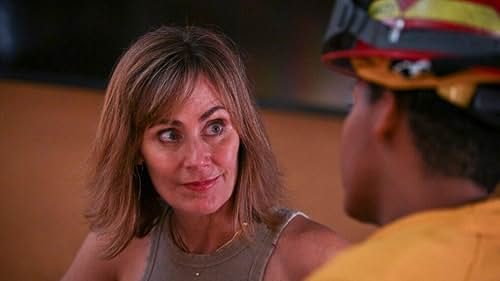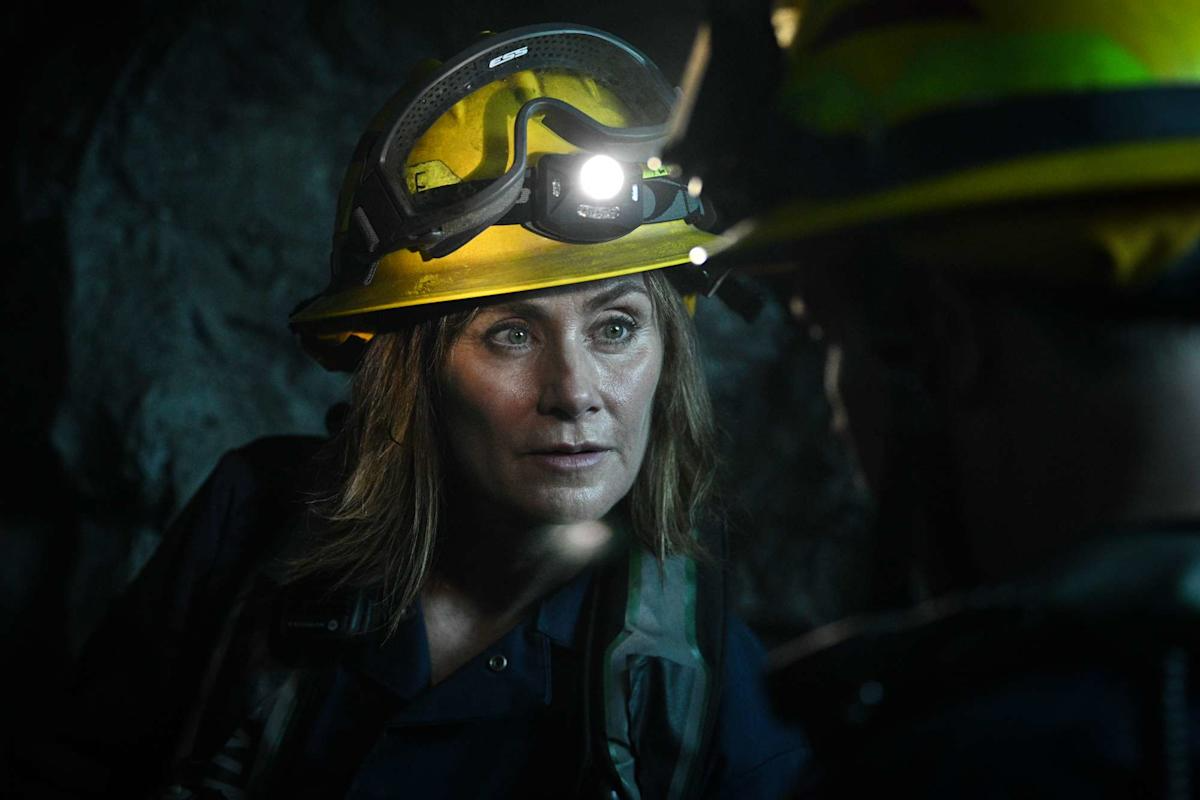
If you watch Fire Country, you know the scares usually come from roaring flames, risky rescues, and tight moments. But for Diane Farr, stepping behind the camera brought a different kind of fear. She recently opened up about her scariest day directing the show and how small changes in the Vince & Sharon scene made all the difference. Let’s go inside what she revealed, from the fire drills to the intimate moments, and see how directing while also acting transformed the show.
Diane Farr’s Leap Into Directing
A New Role, Bigger Responsibility
Diane Farr has played Sharon Leone with strength and vulnerability, but directing her first episode pushed her into a whole new world. Suddenly she wasn’t just responsible for one character; she was responsible for the tone, for others’ performances, and ensuring safety in risky scenes.
Why This Episode Was Especially Challenging
The episode in question involved fire drills inside a brick building that had to be lit on fire for the scene. Farr described it as “the scariest day” because of how physically demanding and dangerous it felt. Gear is heavy, heat is oppressive, and the crew had to juggle technical filming needs with safety.
“The Scariest Day”: Fire Drills & the Heat of It All
The Physical Toll of Fire Scenes
She explained that wearing full firefighter gear for hours in an enclosed, burning-set is literally backbreaking. It’s not just the flames; it’s also the weight, the sweat, the risk. The gear restricts movement, the heat makes everything harder, and everything around you has to operate with precision.
Balancing Safety and Drama
Farr kept worrying about whether scenes would be unsafe. Shots had to be redesigned, sometimes last-minute changes made because something wasn’t safe enough. Despite that, the crew kept pushing forward and finished what they needed within the day. That sense of responsibility weighed heavy on her throughout.
Directing While Acting: Double Duty
Switching Between Roles
Diane didn’t just direct; she acted in many of the same scenes. That means moments where she had to be Sharon Leone in front of the camera, then immediately check choices as the director behind it. It’s tough: you can’t fully lose yourself in one role when the other role demands you oversee the big picture.
Managing Emotional Load
When you’re both in front of the camera and calling the shots, you carry extra emotional weight. Farr noted how especially during fire scenes, you need to both feel the character’s fear and also ensure the crew is safe, the lighting is right, and every shot works. It’s a balancing act few get to do well.

The Vince & Sharon Scene: From Quiet to Powerful
Why That Scene Carried Extra Weight
Vince & Sharon have had a layered relationship through Fire Country. There’s love, tension, guilt, parenting woes, and shared trauma. When Farr directed a scene where they physically come together (a hug from behind, for example), she wanted the camera to see more than just body language — she wanted expression, nuance.
How Farr Changed the Blocking
Originally, the scene was blocked more straightforwardly: characters standing, hugging. Farr decided to tweak it: getting Sharon behind Vince so we could see Vince’s face, letting the audience read his expression. It’s in small physical shifts like that where emotional truth emerges.
Legacy, Identity & Parental Dynamics
Sharon & Vince Trying Not to Over-Parent
Another big theme Farr emphasized is Sharon and Vince trying not to over-parent their adult son, Bode. Both grapple with what it means to let him make mistakes, to give him space, while also wanting to protect him. That tug-of-war shows up in many scenes and layers of the drama this season.
Reverse Empty Nest Syndrome
With Bode returning to their lives more fully, Sharon and Vince are figuring out who they are outside just being mom and dad. Farr notes that both have to balance their identities, work, and parenthood and that tension is uncomfortable but also real and necessary.
Quieter Moments, Big Impact
Physical Connection Speaks Louder Than Words
Moments of silence can carry weight. Farr revealed that blocking scenes isn’t just about dialogue — it’s about how people stand, where hands are, how close they get, how they approach each other physically. That hug behind Vince, the glance, the small touch — these things transmit more than lines sometimes.
Melancholy & What Could Have Been
In the car scene after a big reveal/drama, Farr talks about how she wanted that moment to feel normal for once: Bode in everyday clothes, family present. But underlying that is melancholy: love that’s complicated, moments missed, words unsaid. That contrast of normalcy and emotional tension makes people lean in.
Production Constraints & Creative Choices
Small Spaces, Big Fires
Shooting inside small buildings on fire is no small feat. The limited space, extreme temperatures, and safety concerns force creative problem solving. Directors often redesign shots to reduce risk — maybe shift the angle, reduce time in flames, modify the movement.
Timing, Temperature & Trust
Farr had to trust her crew heavily: stunt teams, safety officers, camera operators. When everyone is working hot and exhausted, mistakes are easier. So preparation, communication, and staying ready to pivot are essential.
Sharon & Eve: Female Power & Vulnerability
Leadership Under Pressure
Farr also spoke about scenes between Sharon and Eve (her subordinate and sometimes friend) that showcase two women holding it together in male-dominated spaces. When they get to drop the shield of command, the show lets us see their vulnerability. That makes them real — not just “strong women,” but human ones.
Work Identity vs Parental Identity
For Sharon, the tug between work as Chief and her role as parent (especially with Bode’s return) adds deep emotional texture. Farr says this season especially tests “who Sharon is” when parental saving isn’t the anchor it once was.
What Fans Should Watch for in These Scenes
-
Expressions in still moments: When characters aren’t talking. Watch their faces.
-
Spatial dynamics: How Sharon & Vince move around each other — distance, closeness, gestures.
-
Visual contrasts: The small sense of “ordinary” (car rides, laughter) clashing with the extraordinary (fires, danger).
-
Physical cost: Scenes where gear, fire, fatigue show not just in what’s said but in how characters carry themselves.
Personal Reflections from Diane Farr
On Age, Trying New Things & Fear
Farr admitted that directing in her 50s felt more daunting than it might have at 30. Fear of failure, fear of doing something unsafe, fear of not being able to do everything — that was part of the experience. But for her, showing up anyway, with heart and intention, mattered.
Learning the Meta
Because she has acted for many years, Farr says she often sees both the character’s needs and the larger story demands. Directing let her use all parts of herself — instincts, experience, emotional insight — in ways she hadn’t before.
Why All These Details Matter for Viewers
-
They deepen the emotional stakes — once you know how hard a shot was made, how much weight a scene carries, you see it differently.
-
They elevate otherwise quiet moments into memorable ones. We remember not just what was said but how it was said.
-
They make characters feel lived in. When you see gear chafing, exhaustion in posture, complicated love — the show feels real.
Conclusion: The Power Behind the Flames
Diane Farr’s journey directing Fire Country shows us how much work, courage, and care go into making moments that feel effortless. That “scariest day” wasn’t just about literal fire; it was about the heat of responsibility, vulnerability, and artistry. Changing a hug, re-blocking a scene, balancing scenic destruction with personal connection — those are the things that leave a mark.
When we watch Vince & Sharon share a look, or Sharon stand back so Bode can step forward, we see more than TV drama. We see real lives reflected, messy, brave, hopeful. And we’ll keep watching, because shows like this remind us why stories matter—and why acting and directing with heart changes everything.
Frequently Asked Questions
1. What episode did Diane Farr direct that included the “scariest day”?
She directed Episode 3 of Season 3, which involved especially challenging fire drills inside a building.
2. What made that day so scary for Diane Farr?
Between the heat, the heavy gear, safety concerns, tight spaces, and balancing acting and directing — it was a high-pressure, high-risk day.
3. How did Farr change the Vince & Sharon scene to be more impactful?
She adjusted the blocking so Sharon approaches Vince from behind, allowing more subtlety in Vince’s expression, deepening emotional connection beyond just the hug.
4. What themes does Farr say are important this season for Sharon & Vince?
Identity, legacy, becoming more than just parents or firefighters — but partners, leaders, people with lives outside their trauma and roles.
5. Will Diane Farr direct more episodes of Fire Country?
While she directed that one intense episode, she’s expressed interest in doing more but also acknowledges the cost — time, energy, and balancing her on-screen role.
